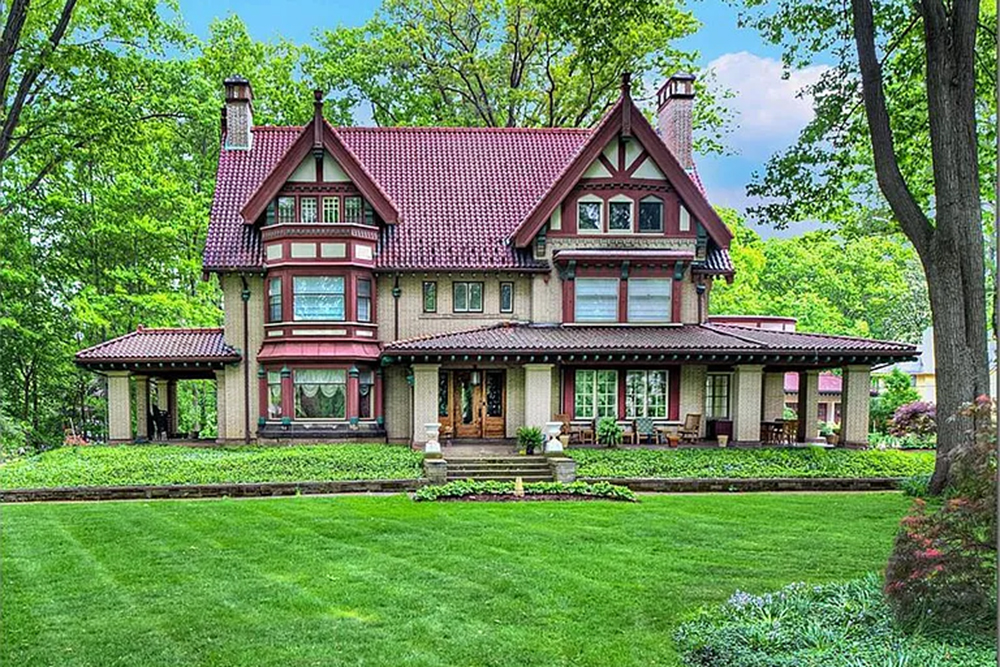
Harlen Shimmin: Specialized in upscale homes throughout Northeast Ohio
Born on March 30, 1874, Harlen E. Shimmin was a native Clevelander and was educated in the city’s public schools as well as a local business college.
His first job was work as a mechanical draftsman—another example of someone whose path to architecture was roundabout.
By the early 1890s he was employed by Charles W. Hopkinson, an 1887 graduate of Cornell University, and Shimmin’s first direct exposure to the life and work of an architect.
Armed with his new degree in architecture, Hopkinson worked in New York City for the next three years before returning to Cleveland. He became known for his house designs in Lakewood. While Hopkinson’s reputation was based largely on private buildings, a notable exception was his supervision of a renovation of the James A. Garfield Monument in Lake View Cemetery.
Born 10 years before Shimmin, he outlived him by a decade. Hopkinson lies buried in Riverside Cemetery.
He was an excellent role model and mentor at the start of Shimmin’s career.
By 1904 Shimmin was in business for himself—launching a career that would last into the 1940s.
Shimmin’s work extends from the Edgewater neighborhood on Cleveland’s west side to Shaker Heights. His specialty was substantial brick homes for Cleveland’s upper middle class.
 Front view of the Widlar Company Building in Cleveland designed by architect Harlan ShimminHis work is exemplified by very substantial materials, primarily brick and stone, and executed in the Tudor Revival Style. His houses were expensive when built, and seem to have remained in loving hands since, judging by the large number that survive intact today.
Front view of the Widlar Company Building in Cleveland designed by architect Harlan ShimminHis work is exemplified by very substantial materials, primarily brick and stone, and executed in the Tudor Revival Style. His houses were expensive when built, and seem to have remained in loving hands since, judging by the large number that survive intact today.
Over time these houses came to number in the dozens. More than a century later, many still exist.
The high quality of these houses was recognized from the beginning, with Shimmin’s work on the 1910 Arlington home he designed featured prominently in the February 1913 edition of “The Ohio Architect, Engineer, and Builder.”
Known as the William R. Jeavons House, at 2541 Arlington Road in the Shaker Farm Historic District, the beige brick home was built for Jeavons, the founder of the Perfection Stove Company. It became a Cleveland Heights Landmark in 2000.
Another notable survivor is located on Attleboro Road in Shaker Heights. Built for John R. Nutt in 1915, it is typical of the homes Shimmin designed for Cleveland’s business leaders.
Nutt began his career as the proprietor of a jewelry store in Akron in the 1890s.
Cleveland Home designed by Cleveland architect Harlen E. Shimmin by photographer C. T. MeachamComing to Cleveland in 1901, he entered the banking industry and rose rapidly through the ranks.
He became head of the Union Trust Company and served as treasurer of the Republican National Committee. He also is said to have introduced the Van Sweringen brothers to J.P. Morgan chairman Thomas P. Lamont—thereby helping to secure the financial backing that enabled them to transform Cleveland.
Nutt lived in the Attleboro Roadhouse for 30 years, dying there late in 1945.
Shimmin’s own residence on Shaker Boulevard still stands, celebrating its 100th birthday this year.
He was also known for designing the 1910 Noble Road School in Cleveland Heights—replacing the 1876 one-room schoolhouse and in 1922 replaced by the Noble Road Elementary School building that stands today.
He was active in his community, a member of the Colonial Club and the Cleveland Athletic Club. He was a 32nd Degree Mason in the Valley of Cleveland as well as a Shriner.
Almost 50 years after he entered Charles Hopkinson’s office in the early 1890s, Harlen Shimmin was listed as a registered architect as late as 1940.
At the age of 48, Shimmin married widow Nella Kay Ringo on November 9, 1922.
Her first marriage to Frederich Ringo of Ashtabula had lasted just six days in June of 1906.
On June 21, 1941, Harlen Shimmin died at his home in Shaker Heights, at age 67.
Nella survived him for 25 years, taking her place beside him in Lake View Cemetery in October 1966.
This article is gratefully dedicated to the memory of my friend Christina Wilkinson. She held a B.A. in Historic Preservation and wrote two well received books about local and regional history. She encouraged my interest in writing in its very earliest stages many years ago. We subsequently worked together for years on a local restoration project. She was my friend for forty years and I will miss her.
 Cleveland Masterworks is sponsored by the Cleveland Restoration Society, celebrating 50 years of preserving Cleveland’s landmarks and cultural heritage. Cleveland Restoration Society preserves houses through the Heritage Home Program. Experience history by taking a journey on Cleveland’s African American Civil Rights Trail.Become a member today!
Cleveland Masterworks is sponsored by the Cleveland Restoration Society, celebrating 50 years of preserving Cleveland’s landmarks and cultural heritage. Cleveland Restoration Society preserves houses through the Heritage Home Program. Experience history by taking a journey on Cleveland’s African American Civil Rights Trail.Become a member today!
About the Author: Tom Matowitz
Recently retired after a 37-year career teaching public speaking, Tom Matowitz has had a lifelong interest in local and regional history. Working as a freelance author for the past 20 years he has written a number of books and articles about Cleveland’s past. He has a particular interest in the area’s rich architectural history.









